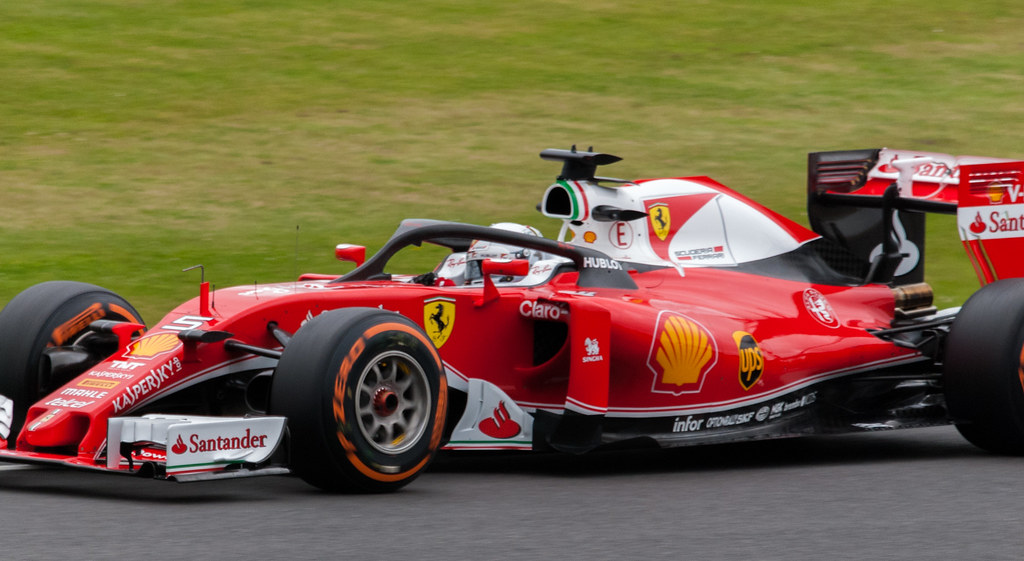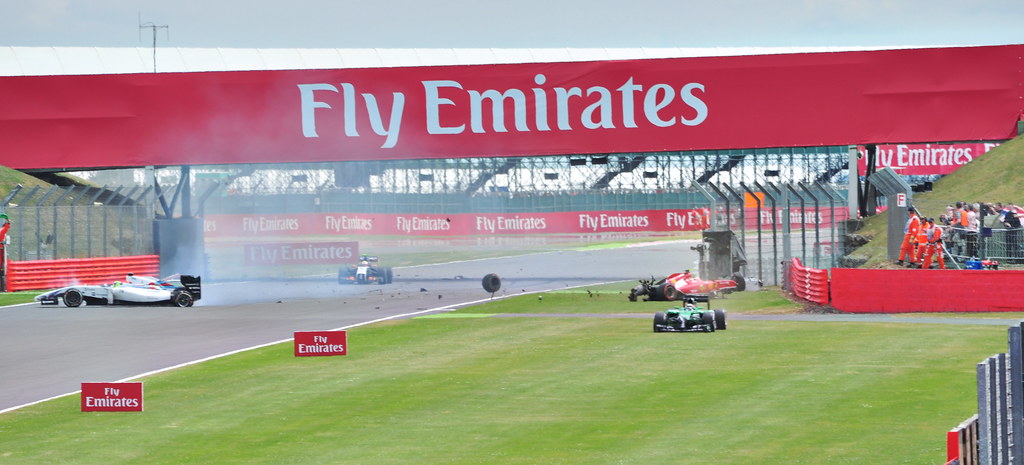What is the number one rule for each participant of Formula 1 who works with the cars? Right, to take on the helmet because safety comes here first. Moreover, this sport has taken a significant step forward, providing additional measures to protect drivers in the last twenty years. What can happen, you may say, as Formula 1 went far from its origins in the 1950s and became fully refuged? Yes and no. Sometimes, the water, fire, loads, and debris make the situation outstanding, unpredictably testing the current devices. Let’s focus on the F1 helmet safety features that guarantee drivers reliable protection no matter what.
But, before we start, why helmet, and why is it not the only one?

F1 Drivers’ Safety In Formula 1: HALO-Helmet-HANS
The main risks in Formula 1 are g-forces. It is not only about speed but also about the difference the drivers experience during acceleration, deceleration, and especially during crashes. It can soon harm the racers if the devices are not. Why is this happening?
Each part of the driver’s body must be protected, while the head needs additional guarantees. The case is in the human’s physiological features. The bundle head-neck is the most vulnerable part. The head at high g-forces becomes weightier as much as loads impact, and it must be strengthened and unmoved to endure this mass.
Remember the accident with Gilles Villeneuve at qualifying for the Belgian Grand Prix in 1982. He hit Jochen Mass’s car and went into the air at 225km/h. After a massive airborne, he nosedived into the ground. Strapping to a seat didn’t guard his neck.
Therefore, the driver’s head protection isn’t confined to just a Formula 1 helmet, so that is a vital part of a chain of devices: HALO-Helmet-HANS.
The HANS, or the Head and Neck Support, appeared in Formula 1 in 2003. The device fixes the neck’s movement. Even though the drivers are uncomfortable, their necks are motionless, whether they race at 350km/h or not.
The HALO is the titanium barrier around the cockpit that protects the driver’s head when the car is flipping, crashing into the wall, or colliding.
In this order, HALO-Helmet-HANS devices work together to provide the maximum guard. Therefore, when we talk about F1 helmets, we mean these three. Although, its value is hard to overestimate.
F1 Helmet Safety Feature №1: As Strong As Bank Vault
Modern helmets in Formula 1 have nothing in common with their ancestor in 1952. Did that soft leather cap guarantee the safe of a driver? Of course not, nor its followed hard-shelled successors.
The age of racing equipment designed primarily to protect the drivers started in 1962 when the Bell brand set the gold standard with their certificated 500TX. The Bell has led the manufactories, and after a while, Arai, Stilo, and Schubert completed the brands the current drivers use in Formula 1.
However, Bell or Schubert, it doesn’t matter. Today, all the helmets drivers wear in Formula 1 must be certificated under FIA 8860 regulations. That is where their safety features become evident.
The certificated FIA 8860 F1 helmet is famous for its straightening and withstands the force of 275G. And, without a tiny scratch, it endures the hitting of a 1.5-tonne car on both sides.
This F1 helmet safety feature guarantees the driver’s head will be protected even if something turns wrong, as happened at the Italian Grand Prix 2021. Thus, it was hard to imagine what could have been with Lewis Hamilton’s head after Max Vertsapen’s car’s rear right wheel got on the Mercedes board if not for the HALO and helmet.
However, enduring masses is not the only feature that proves the Formula helmet to be a paramount device.

The Reliable Protection Of Both Head And Eyes
So, regarding the FIA 8860 requirements, helmets in Formula 1 must be bulletproof and pass the test by throwing 4 kg of “pike cargo.” If there is the slightest dent, the item will be banned.
However, if not for the accident with Felipe Massa in the 2009 Hungarian Grand Prix, there wouldn’t be ballistic testing for a long time.
Massa crashed due to his face being struck by a loose coil of going ahead Rubens Barrichello’s car at 240 km/h. The Brazilian was injured, but not seriously. However, after ten years, the Italian brand Stilo pulled head protection to the next level, revealing a new golden standard: a ballistic-tested concept in 2018.
Furthermore, the visor withstands the shot of a gram bullet at three points: front, top, and back.

F1 Helmet Safety Feature №2: As Lightweight as Liter Of Water
The helmet in Formula 1 must be lightweight, preventing the load on the neck. The weight doubles when the car accelerates or decelerates, and if the device weighs about 3 kg, it reaches about 6kg at the pikes of the speed, causing the loads on the neck and shoulders.
However, the F1 helmet weighs no more than a liter of water – 1.25 kg., which can vary according to the driver’s head size and brand.
How is it possible?
The case is in material, a super light 17 carbon fiber layers with high-density foam, absorbing all the impact and distributing weight during significant crashes.
Besides carbon fiber, it is stuffed with space materials like Kevlar, Polyethylene, Polycarbonate, Epoxy Resin, Aluminum, Magnesium, Titanium, and Nomex for resisting fire.

F1 Helmet Safety Feature №3: It’s Fireproof
Where is it cane the fire on the track, you may say?
Well, everything is possible during the race, and the incident with Romain Grosjean at the Bahrain Grand Prix in 2020 proves it.
He crashed his Haas and got trapped, spending 27 seconds trying to leave the car in the fireball, while HALO saved the driver’s head against hitting the barrier.
Despite Grosjean’s eyebrows and eyelashes melted, his helmet withstood the fire curtain.
So, with balaclava, the the paramount item resists temperatures of 700°C for no less than 45 seconds while the inside temperature has remained below 70°C.
As for the driver’s eyes, the shockproof visor is made of Lexan and holds an outside temperature of 800°C.
Takeaways
In terms of safety, Formula 1 suits technologies ahead of the curve. As for its major devices, the story of when the F1 helmet became a main guard started with the Bell brand over 60 years ago.
The golden safety standards for helmets are described in the FIA 8860 regulations. And some of its safety features can make you wonder.
For example, today’s F1 helmets withstand huge mass impacts and high g-forces. These are fire and bulletproof while weighing no more than a bottle of water.
However, the safety of the driver’s head is not about the helmet only, as the device works in connection with HANS and HALO devices. HANS takes the hit while HALO fixes the driver’s neck against the movements.

Altogether, this supports and guards the most vulnerable driver’s body parts – neck and head; in racing at minimum and maximum speeds, in the rain and sun, and during accelerating on straightforward and even hard-braking incidents.
So, next time you hear that certificated Bell, Stilo, Arai, and Schuberth F1 helmets cost about $5000 – $9000, do not wonder. It is the price for protection at high speed.
References
- Motorsport, Rebecca Braybrook ‘Everything you need to know about F1 safety gear‘ (March 5, 2024), https://www.motorsport.com/f1/news/f1-safety-gear-key-features/10583209/#:~:text=Helmets%20consist%20of%20a%20carbon,provide%20maximum%20protection%20to%20drivers.
- Racecar Engineering, Alto Ono ‘How the Formula 1 Halo works‘ (June 21, 2023) https://www.racecar-engineering.com/tech-explained/tech-explained-formula-1-halo/
- FIA STANDARD GUIDELINES HELMETS (2023) https://www.fia.com/sites/default/files/guidelines_helmets-to_publish_bd.pdf
- F1chronicle, Jarrod Partridge ‘How Does HANS Device Work?‘ (March 11, 2024) https://f1chronicle.com/how-does-hans-device-work-formula-1-technology/



Leave a Reply